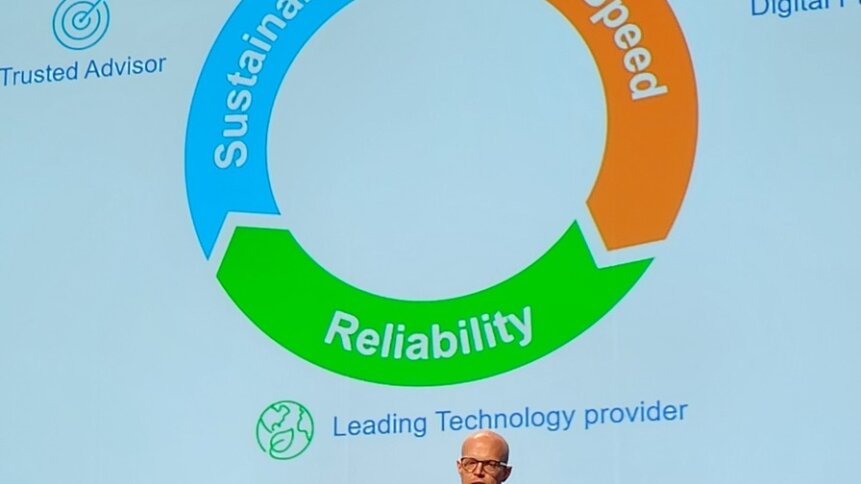Kickstart Europe – state of the data center market

While kicking off a data infrastructure conference with a talk about measuring elephants might be seen as delightfully quirky, what everyone at Kickstart Europe most needed to know before they could properly embark on a day of networking was what the state of the data center market actually looks like as we head into 2023. On the answer to that question depended the mood of the conference – and the forecasts of profit, loss, actionable innovation and methodologies to deal with the opportunities and challenges of the year.
Fortunately then, Steven Brown of Schneider Electric was on hand to balance the books and deliver a state of the market address that, while never straying into boy scoutism, had the ring of truth about its ultimate optimism.
The state of the world.
The state of the data center market in Europe, he said, was balanced against a state of overall, generalized uncertainty. There was, after all, an ongoing European war that was just reaching its grim first anniversary of active conflict. There were rising costs of living as a result of that war, and as much as they applied directly to bread on the shelves of end users’ supermarkets, the consequences of the war were also felt throughout every industry in the region, through choking supply chains, skyrocketing energy costs, high inflation and subsequently elevated material costs.
The economic uncertainty was having an impact around the world, but it was being felt perhaps most keenly in Europe, closest to the center of the action.
And in addition to the consequences of the illegal invasion of Ukraine, there was a real uncertainty over the increasing effects of climate change, and in particular, uncertainty over how much longer traditional – and relatively new high energy-spending industries like data centers – could continue to operate in an ecological vacuum.
But before the audience broke out their self-bemoaning violins, weeping into their handkerchiefs and swigging from a flask of something hot, Brown said there was also, within the data center market, a microclimate of unprecedented demand. He explained to the Kickstart crowd that 2023 was a year when great opportunities and great challenges would dominate the industry – and that by tackling the latter, the industry could only serve to maximize the former.
The big three.
Of the challenges the industry faces across the course of the year, Brown said the biggest three were actually entirely independent of the strife that’s harrying the rest of the world. That’s possible because of the incredible boost to demand for data centers and the cloud-centered world they have delivered through the Covid-19 pandemic and into the post-pandemic world of cloud-native businesses.
Those three big challenges, he said, would be speed, reliability, and sustainability. “Those are three inter-related moving targets,” he added, a little ruefully. “You’re not especially likely to manage to deliver all three at any one time.”
In terms of speed, he explained that in 2023, there would be no room for compromise, because the market has been allowed to expect immediacy of connectivity, and having delivered throughout a pandemic when the speed beforehand had been questionable, the market is unlikely to look favorably on an industry dropping the ball on speed in a world that is no longer locked down.
Businesses in particular have come to rely on speed of connectivity throughout the pandemic and beyond, both to deliver business as usual and in many cases, to underpin their whole reason for existence and the way they deliver their services.
There are also significant speed issues in terms of the deployment of new data centers – they are by no means inconsiderable undertakings, and the demand for more capacity means building more of them. The question of whether the industry can scale itself at the speed of market demand is one with which it has to wrestle in 2023.
The state of the grid.
Speed though is of little use if it can’t be delivered with reliability. And that’s potentially a real issue for the data center world when it comes to ensuring grid reliability against the backdrop of mission criticality for those businesses that are cloud-centric. To some extent, grid reliability depends on scaling to meet demand at the kind of speed that the market can take, but it also depends on energy costs – which are a particular issue across Europe in the wake of Russia’s illegal invasion of Ukraine, and the subsequent actions taken to force a resolution to the conflict.
In terms of speed, Brown brought good news, in that technology was evolving to take some of the time out of the design and build phases of data centers. In particular, the greater, more cost-effective use of digital twin technology was taking up to 30% off the pre-digital timescale to deliver a new data center. More capacity, more swiftly delivered, will hopefully result in more capacity and the growth of the industry as a whole.
And on reliability, Brown said that technological evolution was “widening the lens of the data center,” to allow it to do more, and deliver the needed reliability to establish a strong future for data centers as a ubiquitous part of 21st century life and business.
The green factor.
But sustainability, said Brown, would impact everything data centers did – and how they did it – in 2023, as the world and the industry put ecology and the need to protect the planet at the forefront of its concerns.
“You need a bold, actionable strategy, implementing efficient design, driving sustainability in operations. You need to buy renewable energy. And you need to decarbonize your supply chain if you’re going to deliver sustainability in 2023. Fortunately though, technology is emerging, and moving fast, to allow you to do just that,” he said.
The crowd breathed a sigh of relief – but took onboard the complex nature of the challenges ahead, too.










